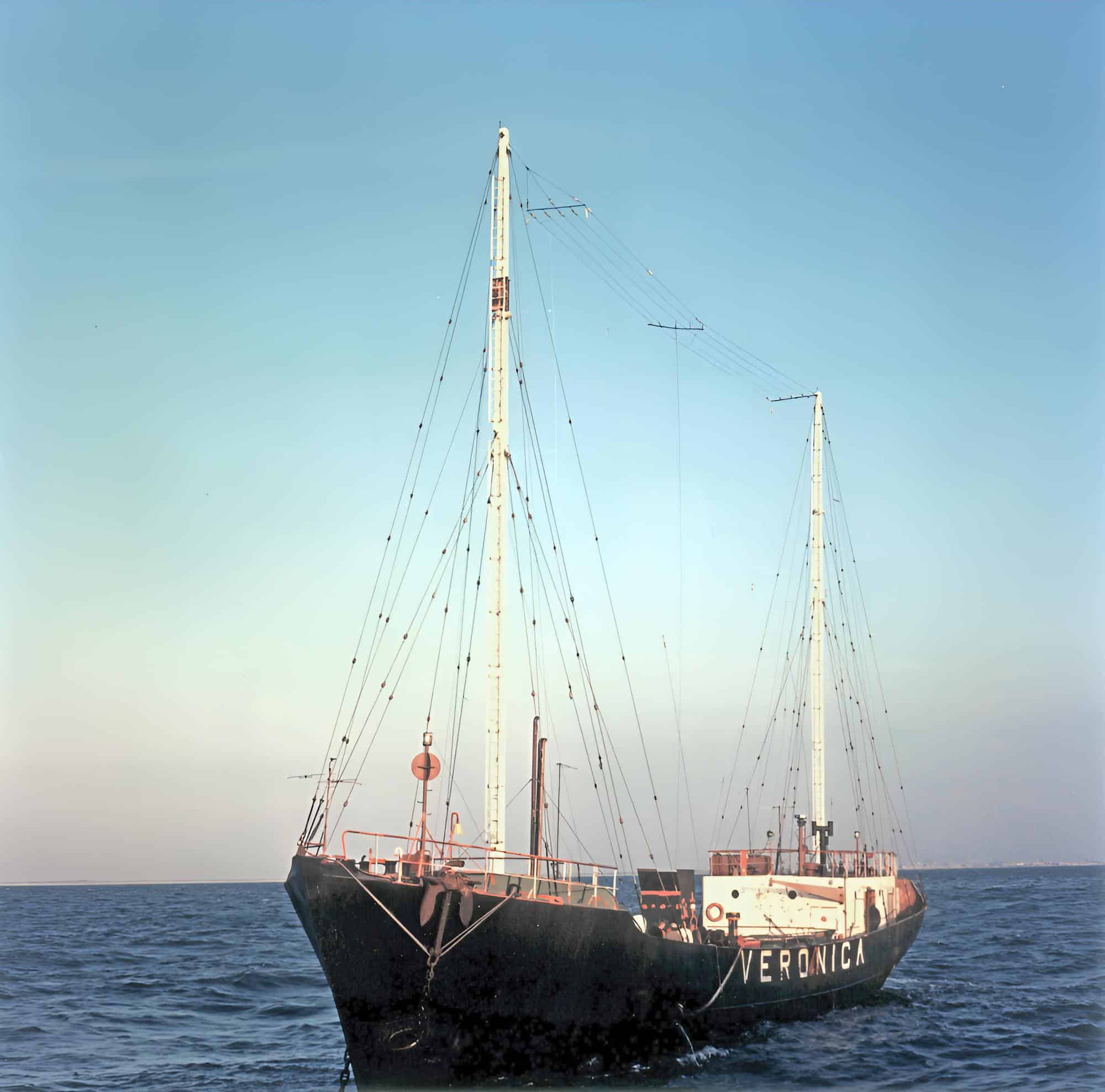Ship details: The 399 gross ton 44.05 metres long and 8.22 metre wide M.V. HH 294 ‘Paul J. Müller’ was built in 1949/50 by the Deutsche Werft AG in Finkenwerder/Germany for the Paul Müller shipping company in Hamburg. The vessel should serve as a fishing boat in international waters off Iceland. In July 1956, the vessel was sold to the Niedersächsische Hochseefischerei GmbH in Cuxhaven and renamed NC 420 ‘Norderney’. In 1960, the ship was sold to be scrapped in the Netherlands. The vessel entered Ijmuiden on 9th October 1960. Later it was towed to Haarlem and then spent some years in Spaarne. In 1964 Radio Veronica bought the vessel as a replacement for the Borkumriff. At this time the former owners had already begun to break up the ship which had been loosing her steering room and the bow mast.
The ship was rebuilt at the ZSM Zaanlandse Scheepsbouwmaatschapij in Zaandam/Netherlands. The Dutch press was mislead by the story the ship should serve as a broadcasting vessel in the German Elbe estuary as there were strong rumours that the former Hamburg Star Club owner Manfred Weissleder was preparing a German offshore station to be called “Radio Star Club”. Norbert Jürgens led the major rebuilding of the ship which inluded the removal of the motor and the erection of two wooden 24 metre masts.
A 10,000 Watt transmitter was installed. In September 1964 the Norderney was towed from Zaandam and anchored off the coast of Scheveningen. A day after the Norderney anchored off the Noordwijk coast a disaster was narrowly avoided when the Norderney lost her anchor and nearly ran aground. The ship was towed back to her anchorage by a Dutch coast guard vessel. A new anchor system was installed which lasted until the 2nd April 1973. On 16th November 1964 the Wijsmüller ship Nestor towed the Norderney to a position off Katwijk aan Zee, and the vessel replaced the Borkumriff. [Information above by Jan Sundermann, Radio News, Millennium Edition, September 2000. Additional source: Jack van der Valk, IJmuider Courant]
During the night of 2nd April 1973 a hurricane force storm blew up, the worst in living memory, at 20:54 hours the Norderney announced she had lost her anchor and was drifting towards the shore and taking in water. The lifeboat Bernard van Leer put to sea and an hour later the lifeboat had taken four crew off the ship and stood by. Finally the remaining six men were taken off by the lifeboat. With no engine the Norderney was at the mercy of the waves. By 23:30 hours she was aground, fifty yards from Scheveningen harbour. On 3rd April the lifeboat was unable to enter the harbour until 10:00 hours, because of the severe conditions. No action was taken by the PTT, although broadcasts did not stop until the ship was well within Dutch territorial waters. Smit-Tak of Maassluis were given the job of refloating the ship. They dug a deep channel to allow the sea to reach the ship. On 7th April 06:00 hours the ship had been turned to face the sea, but they still could not free her. On 18th April 1973 the Norderney was refloated at 04:00 hours. An hpur later the ship was back at her anchorage.
After closing down on 31st August 1974, the Norderney remained at sea. Work was carried out on the ship and caused speculation that the ship was going to be used for another offshore project. Finally, on 12 August 1975, the ship was towed into Amsterdam’s Entrepothaven, where it was immediately seized by the Radio Controle Dienst and police upon entry. On 28 August 1975, under the watchful eye of Bull Verweij, the transmitters were removed from the ship, after which, on 2 September 1975, the seizure of the Norderney was lifted. On 26 November 1975, the ship was transferred to the Czaar Peterwerf in Zaandam, the same yard where it had been converted into a transmitter ship in 1964. Owner of the ship, meanwhile, was the Veronica Omroep Organisatie (VOO), which wanted to turn the ship into a museum. On 14 April 1976, recordings were made aboard the Norderney, which was still at the shipyard in Zaandam, for the VOO’s first television broadcast night. On 9 August 1977, more than two years after the Norderney had been towed to Amsterdam harbour, the ship was towed out to open sea once more, to anchor just off the Scheveningen Pier, for the purpose of television recordings for the programme ‘The Day the music died’.
Nothing came of the plans to turn the Norderney into a museum. On 20 October 1977, the ship was sold to Jacques Mooren of Handels- en Scheepvaartbedrijf Kalkhaven BV, who immediately set up the Stichting Veronicaschip with the aim of preserving the Norderney in its original state. Subsequently, the ship was sold several more times, and thoroughly converted into a discotheque/café. The ship has been located in places such as Doesburg, Lelystad, Groningen, Maastricht, Dordrecht, Vlissingen, Middelburg, Leeuwarden and Papendrecht. After the radio ship had been in a port in Antwerp for about two years, the ship was towed to Groningen in 2012, with a brief stop at the Oranjewerf in Amsterdam, to serve as a media ship after a thorough refurbishment.
The ship then went back to the IJ in Amsterdam-North, where it has been berthed at the NDSM site since 17 November 2013, where it served as a “multifunctional activity centre.” Since May 2018, it has housed a nightclub and restaurant.
https://www.hetveronicaschip.nl
Offshore radio station: Radio Veronica from 16th November 1964 (replacing the Borkumriff) to 31st August 1974.
On 31st August 2003, Radio Veronica made another relaunch as a licenced radio station in the Netherlands. Exactly 29 years after the offshore station closed down in 1974, Veronica broadcast for six hours from the vessel again.
Location: International waters off Scheveningen (Netherlands). Nowadays moored at the NDSM site in Amsterdam/Netherlands.

